By Jaime Ortega.
History may need to be rewritten. For the past decade all over the world ancient, underwater cities have been discovered. Historians are starting to observe natural patterns that might change teachings of modern day science, which concern origins of civilization.
A faulty agenda that should not be overlooked:
Presently, there has not been enough research conducted to lead us to a definite conclusion as to whether or not underwater cities provide sufficient empirical evidence to confirm the existence of advanced ancient civilizations. Unfortunately, most of the websites that present stories related to underwater cities are not even considered credible by many modern day media networks.
Therefore the question must be posed, “Who is behind the media’s agenda?” as we observe that archaeological discoveries are blatantly passed over which could change our perceptions of history. When archaeological evidence is presented which opposes the “uncontested view” of the modern day theory, will the general public be made aware that new evidence is willingly rejected without scrutiny by a strong, biased agenda?
Modern science’s fear of identifying underwater ruins comes as no surprise and rightly so. Many archaeologists are not keen enough to expose the implications that the existence of ancient cities would actually have in understanding our past.
Without a high-ranking scientist to step forward and allow the gateway for an alternative explanation (other than evolution), it will be impossible to present any data to pass a biased, scientific filter. The information presented to the public sphere supplies an agenda with only one closed-model-system based on a theory that is still far from becoming a universal law.
The argument does not suggest scientist themselves have corrupted the media by banning controversial discoveries or piling up evidence in empty old cabinets, but it raises a question. On what premise, standard or basis should archeology be counted as reliable without evolution branding it as non-historical?

Charles Darwin
” The theory of evolution proposes that man never coexisted with Dinosaurs”
“There was no such thing as a flood”
“I was a young man with uninformed ideas. I threw out queries, suggestions, wondering all the time over everything; and to my astonishment the ideas took like wildfire. People made a religion of them.”
Versus
Ancient History

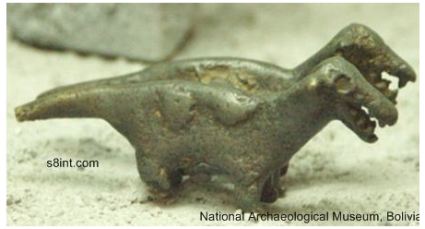
A.D. 200-A.D. 1000, Gold Tiwanaku zoomorphic figurines

Ancient Rock drawing of Plesiosaur in Australia
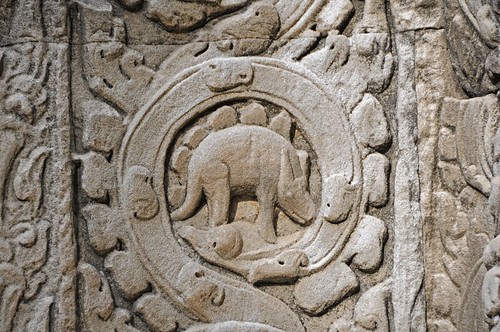
Stereosaurus found in Temple in Cambodia
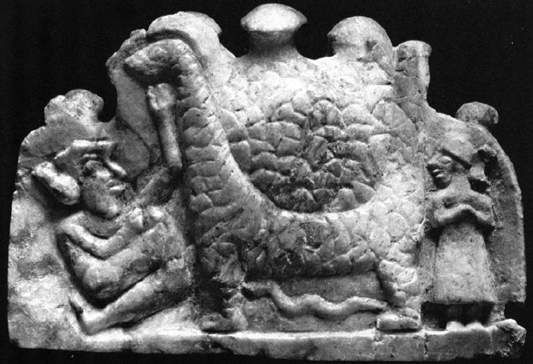
Canaanite ancient Medallion – Snake under what looks like a reptilian creature bigger than the Priest.
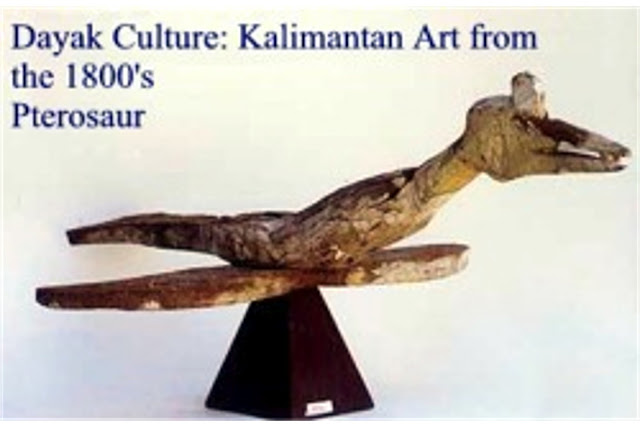
Babylonian Figure shows dinosaur-like paws and snake head.

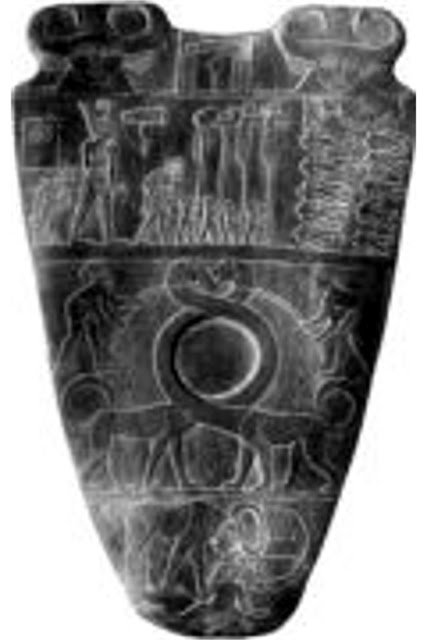 \
\
Ancient Egyptian carving long neck


Boomerang showing what looks to be a sauropod dinosaur

A strange mural from the Greek era showing a monster from the Nile called “Krokodilonardalis” – “Crocodile leopard.”

Greek-Roman wall shows what looks like two sauropods
.jpg)
Inca carved wooden cup

Carving found in Sumatra that many believe is a Corythosaur.
.jpg)
.jpg)
Ruins found of the mysterious Carian culture located in modern turkey

“Arhats (holy men) Ding Yun Peng. Ming dynasty, 1368 – 1644 BC, red and color on paper.” Shanghai Museum


Anasazi petroglyph at the Wupatki National Park – Flagstaff, Arizona

By Dr. Rafael Requena, private secretary to President General Gomez -New York Times June 5, 1932.
Findings that need further analysis overlooked by mainstream journalist:
The Sumerian civilization from the Tigris and Euphrates Rivers (5,000 BC) was originally thought to be the oldest civilization. With new and controversial discoveries found across the world, Mesopotamia is an overshadow of these ancient, lost civilizations.
Bolivia

Stone carvings at Puma Punku show advanced civilization
Puma Punku, Bolivia is the oldest archaeological site ever found. It dates close to 14,000 BC. It has been suggested by a geologist that hardened mud was found in the site, which could have been produced by an ancient flood. Puma Punku is known for its rock cutting techniques that show a high level of technology. The largest of these stone blocks is 7.81 meters long, 5.17 meters wide, averages 1.07 meters thick, and is estimated to weigh about 131 metric tons. The second largest stone block found within the Puma Punku is 7.90 meters long, 2.50 meters wide, and averages 1.86 meters thick. Its weight has been estimated to be 85.21 metric tons. Both of these stone blocks are part of the Plataforma Lítica composed of red sandstone. Based upon detailed petrographic and chemical analyses of samples from both individual stones and known quarry sites, archaeologists concluded that these and other red sandstone blocks were transported up a steep incline from a quarry roughly 10 km from Lake Titicaca. Smaller andesite blocks that were used for stone facing and carvings came from quarries within the Copacabana Peninsula about 90 km away from and across Lake Titicaca to the Puma Punku and the rest of the Tiwanaku site.
New Guinea

Ancient reconstruction of Nan Madol, By Oregon State University

Underwater Remains of Nan Madol
Nan Madol is located in the southwest side of Pohnpei Island, which lies about (16,000 km) northeast of New Guinea. Next to Nan Madol on the southeast corner of Pohnpei is Madolinihmw Harbor, which contains underwater columns in a straight row and assorted sunken ruins, including a so-called castle (60 m) submerged under murky waters. The ruins are mostly squared and rectangular in shape, all built by gigantic blocks of rock, nearly (10 m) in length and weight close to (50 tons). Carbon dating indicates that the construction of Nan Madol dates back to 12,000 BC, while excavations suggest it might have been occupied as early of 200 BC. Archeologists are unsure how it is that the ancient city flooded. Nan Madol was one of the sites James Churchward identified as being part of the lost continent of Mu, starting in his 1926 book The Lost Continent of Mu Motherland of Man
Black Sea and Aegean Sea

Underground Civilization found in Greek Aegean Sea



Sept. 13, 2000—Explorers in an undersea discovery craft came upon remnants of human habitation 311-feet below the surface of the Black Sea, approximately 12 miles off the Turkish shoreline, near the port city of Sinop. The well-preserved remnants of a mud and wattle house are thought to be part of a human settlement at the intersection of two great rivers, dating to a time before the flooding of the Black Sea by the waters of the Mediterranean, an event which probably occurred about 7,500 years before present as a result of glacial ice melt. Columbia University geologist Robert Ballard followed an hypothesis that the discovery could suppose the Mesopotamian origin of civilization, the so-called hydraulic society and the datings of civilization’s origin, the “Neolithic Revolution”. (*Origins of Indo-European language: classifications of early man.)
Japan

Yonaguni 3D reconstruction by German newspaper Der Spiegel
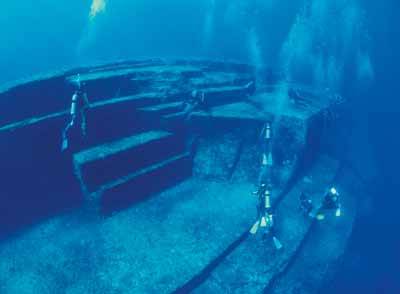
Ancient city of Yonaguni
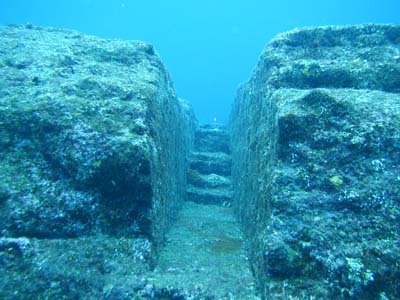
Geological evolutionist, Professor of Boston University, Robert M. Schoch proposed the site was made by “natural causes”
In 1987 while looking for a good place to observe the sharks, diver Kihachiro Aratake, a director of the Yonaguni-Cho Tourism Association, noticed some singular seabed formations resembling architectonic structures. Submerged stone structures lying just below the waters off Yonaguni Jima are actually the ruins of a Japanese Atlantis—an ancient city sunk by an earthquake about 2,000 years ago. That’s the belief of Masaaki Kimura, a marine geologist at the University of the Ryukyus in Japan who has been diving at the site to measure and map its formations for more than 15 years. Each time he returns to the dive boat, Kimura said, he is more convinced than ever that below him rest the remains of a 5,000-year-old city. “The largest structure looks like a complicated, monolithic, stepped pyramid that rises from a depth of (25m),” said Kimura, who presented his latest theories about the site at a scientific conference in June. Some scientists have estimated the site to be closer to a 10,000-year-old city, according to radiometric dating.
India
In May 2001 India’s Union Minister for Human Resource Development, Science and Technology Division, Murli Manohar Joshi, announced that the ruins of an ancient civilization had been discovered off the coast of Gujarat, in the Gulf of Khambhat. According to marine scientists in India, archaeological remains of this lost city have been discovered (36 m) underwater in the Gulf of Cambay off the western coast of India. And carbon dating says that they are 9,500 years old. This news completely contradicts the position of most Western historians and archaeologists, who (because it did not fit their theories) have always rejected, ignored, or suppressed evidence of an older view of mankind’s existence on planet Earth. Human civilization is now probably much more ancient than many have believed. According to the BBC’s Tom Housden reporting on the Cambay find, “The vast city — which is five miles long and two miles wide — is believed to predate the oldest known remains in the subcontinent by more than 5,000 years.” To top the findings, the ancient city of Dwarka was also spotted by a group of marine archeologist off the coastline of present day Dwarka. Dwarka was known as the city of Krishna.
CUBA
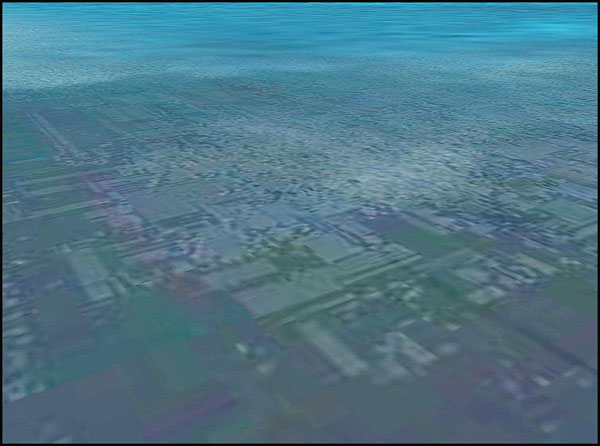
Geometric remains of the lost Cuban Civilization.
Professor of Oceanography from Rhode Island University, Robert Ballard was quoted as saying “That’s too deep, I’d be surprised if it was human. You have to ask yourself, how did it get there? I’ve looked at a lot of sonar images in my life, and it can be sort of like looking at an ink blot — people can sometimes see what they want to see. I’ll just wait for a bit more data”
Despite Ballard’s skepticism, he holds, that indeed a flood took place in one point is history. But despite his point of view do the images look like natural formations?
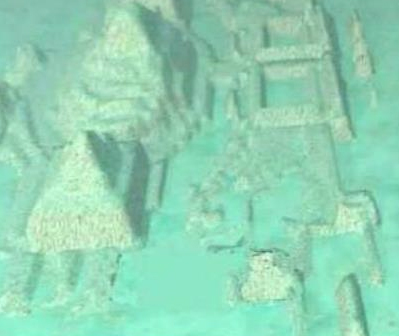
Underwater Structure near Cuba, show geometric shapes
Reconstruction made by The History channel


Rounded, megalithic granite-like rocks with unidentified line detail.
Video image © 2002 by ADC International, Inc.


Sonar shows underwater geometric structures beneath the Cuban Gulf
In July 2000, deep ocean engineer, Paulina Zelitzky discovered a possible megalithic site 2,310 feet below the water off the western coast of Cuba. The underwater city encompasses an area about (20 Square Km) in size, near the Guanahacabibes Peninsula. Using sidescan sonar, Zelitzky, owner and operator of a company called Advanced Digital Communications (ADC), found “in the middle of this beautiful white sand … clear man-made large-size architectural designs.” In the summer of 2001 the researchers returned to film the ruins of the underwater city using a Robotic Ocean Vehicle known as an ROV. Upon close examination they saw a large plateau with organized stone structures that appeared to be pyramids, rectangular buildings, and roads. The researchers believe this underwater “city” was built at least 6,000 years ago when the land was above water. Zelitzky hypothesizes that an earthquake or volcanic activity caused the land to sink. Manuel A. Iturralde Vincent, research director of Cuba’s National Museum of Natural History in Old Havana, viewed the underwater city and confirmed that the shapes are similar to pyramids and streets when seen from above. He also confirmed the existence of large faults and an underwater volcano nearby, and indications of “significantly strong seismic activity.”
Florida-Bimini

The underwater Florida-Bimini ruins show what looks like an ancient road
The June 1981 edition of “Marine Geology” authored by Peter Tompkins, Pino Turolla and David Zink (Italian and U.S. archeologists), found what seemed like a civilization underwater close to the gulf of Florida. It contained paved roads and huge stonewalls. Dr. J. Manson, Valentine from Yale University, found a wrecked Phoenician ship that dated 3,000 years ago. The ruins show some radiocarbon dates on mangrove peat, based on the estimate of Broecker and Kulp, listing dates between 5590 and 3680 BC. Most recently the rate of the sea level’s rise has slowed to 4.5 in (114 mm) per century. Prior to that time it was one foot per century. Near Andros Island, underwater explorer Jacques Cousteau found a huge submerged cave 165 ft. beneath the surface. Z.A. Simon offers an “accurate” map of Plato’s rectangular island with its given dimensions as 2,000 by 3,000 stadia, overlaying its outline on the suspected ancient irregular shoreline of that traditional island in the Bahamas region. (An Attic stadium corresponds to 177.6 m.)
Peru


Divers at exploring Lake Titicaca Ruins, elevation of (3,000 m) above sea level (BBC)
April 30, 2003 — International archaeologists have found the ruins of an ancient temple under Lake Titicaca, the world’s highest lake. Dating back 1,000 to 1,500 years ago, the ruins are pre-Incan. The Incas, who built Machu Picchu, believed they originated from the lake, and they regarded the lake as the birthplace of their civilization. In their myth the Children of The Sun emerged out of the waters. Divers went as deep as (30 m) in their exploration. A terrace for crops, a long road and an 800-metre (2,600 feet) long wall was also found under the waters of the lake, sited in the Andes mountains between Bolivia and Peru. They have been attributed to the indigenous Tiwanaku or Tiahuanaco people, said Lorenzo Epis, the Italian scientist leading the Atahuallpa 2000 scientific expedition. The holy temple measures (200m) by (50m) almost twice the size of an average football pitch. More than 200 dives were made into the lake to depths of as much as 30m in order to record the ruins on film. The explorers found the temple after following a submerged road, in an area of the lake not far from Copacabana town. The Machu Picchu civilization, said it originated from another civilization now covered by the lake.
Israel


(Left) 9,000 B.C. old mother found (Right) Ancient underwater well

Ancient temple of worship
Dating to as early as 6900 B.C., Atlit-Yam is a pre-pottery Neolithic settlement covering more than 15 acres of the seafloor just off Israeli coast, some six miles south of Haifa. Working at a depth of (12 m), archaeologists led by the Israeli Antiquities Authority discovered the remains of rectangular houses and several pits, most likely used as wells. A six-foot thick wall running parallel to the channel of an ancient river was probably a levee, indicating increased control over and exploitation of water systems in the Neolithic. A set of seven upright stones discovered around what used to be a freshwater spring may also indicate worship of water sources. Perhaps most importantly, Atlit-Yam has in situ burials, with 15 full skeletons, some showing evidence of tuberculosis (see “Dark History of the White Death,” September/October 2009). Most remains were found either in or near to a dwelling, which may indicate the people practiced some form of ancestor worship. Early evidence of religion, domestication, and fishing make Atlit-Yam a key site to understand the transition in the Neolithic period toward more complex systems of subsistence. The discovery was made by a group of scientist in Tel Aviv University and Prof. of Archeology Israel Hershkotivz.
In the Mediterranean Sea alone there have been close to 200 discoveries of submerged cities that once were thought as legendary. Recent discoveries on coastal areas in Spain, Italy, England and France suggest that flooding took place at different times in the ancient world. And one major flood that covered all major civilizations in the meltdown of the last Ice Age, more than 100,000 years ago. But radiocarbon dating, the modern technique use for dating, might have to be revalued, as many archaeologist find it problematic in determining the age of certain cities and historical accounts that contradict our modern understanding of age.





